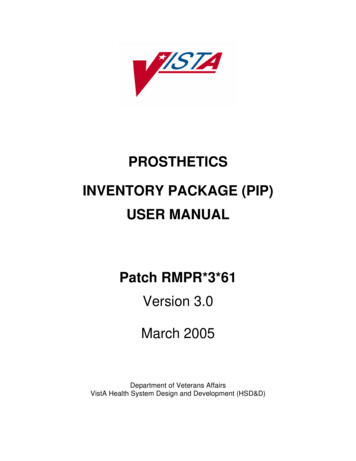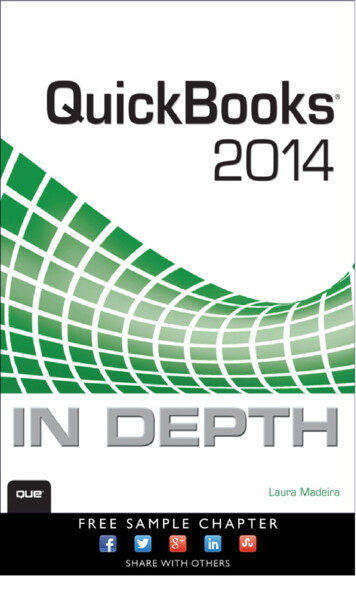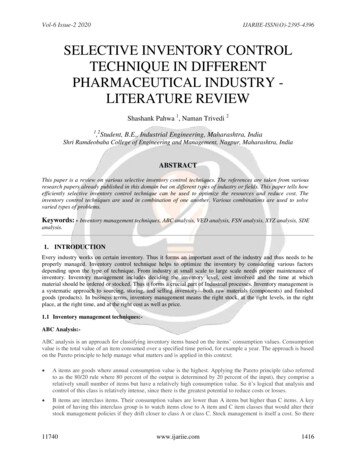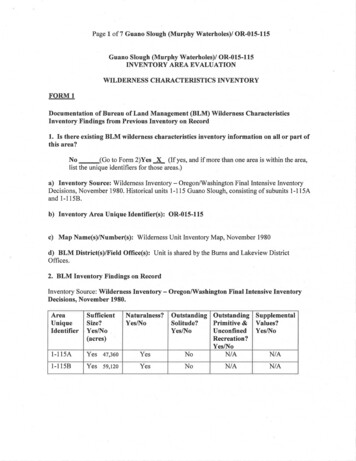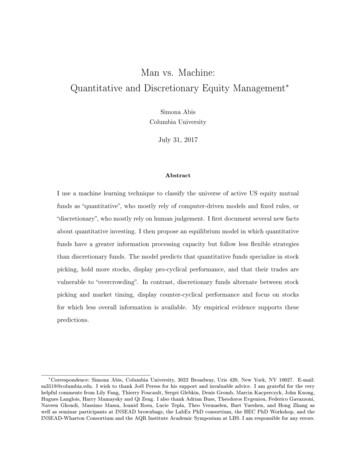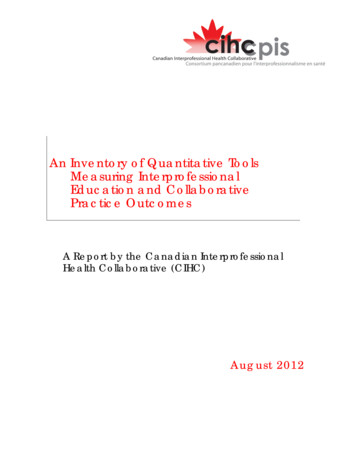
Transcription
An Inventory of Quantitative ToolsMeasuring InterprofessionalEducation and CollaborativePractice OutcomesA Report by the Canadian InterprofessionalHealth Collaborative (CIHC)August 2012
TABLE OF CONTENTSAcknowledgements .2Introduction .3Methods .3Results.7Table 1: Quantitative Tools .9References.56Inventory of Quantitative Tools Measuring Interprofessional Education and Collaborative Practice Outcomes1
ACKNOWLEDGEMENTSThis report was compiled and written by the Canadian Interprofessional Health Collaborative (CIHC)Research & Evaluation Committee’s Quantitative Tools Working Group (members listed alphabetically):Nancy Arthur, University of CalgarySiegrid Deutschlander, Alberta Health ServicesRebecca Law, Memorial UniversityJana Lait, Alberta Health ServicesPatti McCarthy, Memorial UniversityLuljeta (Luli) Pallaveshi, University of Western Ontario and Lawson Research Health InstituteRobin Roots, University of British ColumbiaEsther Suter, Alberta Health ServicesLynda Weaver, Bruyère Continuing Care, OttawaThe Quantitative Tools Working Group acknowledges Daniel Hooker (University of British Columbia) forcontributing his time and expertise to the literature search, Sarah Flynn (University of Calgary) for herresearch assistance, and Judy Burgess (University of Victoria) for her contributions.Inventory of Quantitative Tools Measuring Interprofessional Education and Collaborative Practice Outcomes2
INTRODUCTIONInterprofessional education and collaborative practice have emerged as learning and clinical practiceinitiatives to promote optimal patient care. Interprofessional education refers to “occasions whenmembers [or students] of two or more professions learn with, from and about one another to improvecollaboration and the quality of care” (Centre for the Advancement of Interprofessional Education2002). Collaborative practice is an interprofessional process of communication and decision making thatenables the separate and shared knowledge and skills of health care providers to synergisticallyinfluence the patient care provided (Way et al 2000). Evaluation is a critical component of suchinitiatives; however, finding the right tools to measure outcomes can be challenging.This report provides an inventory of quantitative tools measuring outcomes of interprofessionaleducation or collaborative practice, and describes the development of this inventory. This project wascompleted by a working group of the Research and Evaluation Subcommittee of the CanadianInterprofessional Health Collaborative (CIHC). In 2005, the CIHC was formed to promote collaboration inhealth and education across Canada. The mandate of the CIHC Research and Evaluation Subcommitteeis to strengthen and mobilize research and evaluation capacity in interprofessional education andcollaborative practice in Canada.This comprehensive inventory of quantitative tools measuring outcomes of interprofessional educationand collaborative practice is designed to assist researchers and evaluators in determining which of themany published tools to use in various contexts. This inventory is more recent and/or comprehensivethan other quantitative tool inventories on the same topic (Canadian Interprofessional HealthCollaborative 2009, Carpenter & Dickinson 2008, Heinemann & Zeiss 2002).METHODSInventory focusThe tools in this inventory measure at least one outcome that relates specifically to interprofessionaleducation or collaborative practice. These outcomes are modeled on the work of Carpenter andDickinson (2008) who catalogued 18 tools of interprofessional education sorted according to Barr’s(2005) six-level framework of educational outcomes (which was based on the Kirkpatrick [1967] fourlevel typology). To maintain a consistent approach, we used the Barr (2005) framework to organize thetools in this review, with modifications. We excluded “learner’s reactions” because we were notinterested in participants’ satisfaction with particular learning events, and we replaced “benefits topatients” with “patient satisfaction” to be more precise in identifying what the tools captured. Weadded “provider satisfaction” to capture providers’ perspectives towards their experiences of workingtogether. For both patient and providers, satisfaction had to be directly related to interprofessionaleducation or collaborative aspects of care delivery, rather than satisfaction in general. The six outcomesare shown in Box 1.Inventory of Quantitative Tools Measuring Interprofessional Education and Collaborative Practice Outcomes3
Box 1: Interprofessional Education and Collaborative Practice Outcomes1.2.3.4.Attitudes about other disciplines or about working with other professions;Knowledge, skills, abilities around interprofessional education and collaborative practice;Behaviour: Individuals’ transfer of interprofessional learning to their practices;Organizational level: Interprofessional collaboration at the level of the organization such asorganizational culture and organizational readiness;5. Patient satisfaction: Referring only to the aspects of patients’ satisfaction involving interprofessionalcollaboration;6. Provider satisfaction: Referring only to the aspects providers’ satisfaction involving teamworkprocesses or work environment involving interprofessional collaboration.Literature SearchA systematic search of the published literature was conducted with the assistance of a librarian. Thesearch strategy was designed to capture academic articles related to quantitative measurement ofinterprofessional education and collaboration. Key concepts were searched using MeSH (MedicalSubject Headings) and key words. The search terms used in each database are shown in Box 2. Initially,databases were searched for articles in English from January 2000 to October 2009. A second search wasconducted in May 2010 to retrieve newer publications and to include the terms “validity” and“psychometrics” from January 2000 onward. Although a search of the grey literature was not conducteddue to resource constraints, reports of projects from the Interprofessional Education for CollaborativePatient-Centred Care (IECPCP) initiative, funded by Health Canada from 2003 to 2007, were reviewed forrelevant tools. The tools from the IECPCP reports were included in this inventory if they providedadditional psychometrics on previously published tools or if the tools were not previously published. 1Two hand searches were also conducted. The first search consisted of reviewing references of retrievedarticles if the article contained references about earlier use(s) of a tool or further methodologicaldetails. The second search involved reviewing journals identified by the team as relevant for research oninterprofessional education and collaborative practice. These journals, reviewed from 2000 to 2010,were Journal of Interprofessional Care, Journal of Advanced Nursing, Gerontology & GeriatricsEducation, and Medical Education.Box 2: Databases and Search TermsCINAHLMW ( inter-profession* or interprofession* or inter-disciplin* or interdisciplin* or inter-occupation* orinteroccupation* or inter-institution* or inter institution or inter-department* or interdepartment* or interorganization* or interorganization* or inter-organisation* or interorganisation* or multi-profession* ormultiprofession* or multi-disciplin* or multidisciplin* or multi-occupation* or multioccupation* or multiinstitution* or multiinstitution* or multi-organisation* or multiorganisation* or multi-organization* ormultiorganization* ) and MW ( education or practice ) and MW ( instrument* or questionnaire* or survey orscale or scales ) and MW ( care team or care teams ) and (collaborat*)Medline 2009MW ( patient care team* or interdisciplin* or inter-disciplin* or multi-disciplin* or multidisciplin* or transdisciplin* or transdisciplin* or interprofession* or inter-profession* or multi-profession* or multiprofession* or1For a comprehensive list of all the measurement tools used in the IECPCP projects, see CIHC (2009). Report available atcihc.ca/files/CIHC EvalMethods Final.pdf.Inventory of Quantitative Tools Measuring Interprofessional Education and Collaborative Practice Outcomes4
trans-profession* or transprofession* or inter-occupation* or interoccupation* or multi-occupation* ormultioccupation* or trans-occupation* or transoccupation* or cross-occupation* or crossoccupation* or crossdisciplin* or crossdisciplin* or cross-profession* or crossprofession* ) and MW ( care team or care teams ) andcollaborat* and MW ( questionnaire* or instrument* or scale* ) and MW ( education* or practice* )Medline 2010MW (cross*disciplin* or cross-disciplin* or cross*occupation* or cross-occupation* or cross*profession* orcross-profession*or inter*disciplin* or inter-disciplin*or inter*occupation* or inter-occupation*orinter*profession* or inter-profession* or multi*occupation* or multi-occupation* or multi*disciplin* or multidisciplin* or multi*profession* or multi-profession*or trans*disciplin* or trans-disciplin*or trans*occupation*or trans-occupation*or trans*profession* or trans-profession* ) and (education* or learning* or practice * orcare or instruction*) and (collaborat* or ipe or iecpcp or *Patient Care Team or Patient Care Team orinterprofessional relations or cooperative behaviour or *patient-centered care) and (questionnaires or healthcare surveys or psychometrics or program evaluation or measurement or evaluation or tool or scale orreliab or valid )Web of Sciencemultiprofession* OR interprofession* OR interdisciplin* OR interdepartment* OR interorganisation* ORinterorganization* OR multidisciplin* OR multioccupation* OR multiinstitution* OR multiorganisation* ORmultiorganization* OR multi-profession* OR inter-profession* OR inter-disciplin* OR inter-department* ORinter-organisation* OR inter-organization* OR multi-disciplin* OR multi-occupation* OR multi-institution* ORmulti-organisation* OR multi-organization*ERICDE"Program Evaluation" or "Program Effectiveness" or "Evaluation Methods" or "Evaluation Procedures" or"Formative Evaluation" or DE "Health Services" or "Medical Services" or "Health Facilities" or "Clinics" or"Hospitals" "Health Care Evaluation" or "Medical Care Evaluation" or "Medical Evaluation"andTX "interprofession*" or "interprofession*" or "inter-disciplin*" or "interdisciplin*" or "cross-disciplin*" or"crossdisciplin*" or "multi-disciplin*" or "multidisciplin*" or "multi-profession*" or "multiprofession*" or"multi-occupation*" or "multioccupation*" or "collab*"PSYCH INFODE "Questionnaires" OR "General Health Questionnaire" or "Surveys" OR "Consumer Surveys" OR "MailSurveys" OR "Telephone Surveys" or "Quantitative Methods” "Program Effectiveness" OR "EducationalProgram Effectiveness" OR "Mental Health Program Evaluation" OR "Program Evaluation" OR "PersonnelEvaluation" OR "Peer Evaluation" OR "Organizational Effectiveness" OR "Professional Competency" OR"Employee Skills" OR "Job Knowledge" orTX "inter-profession*" or "interprofession*" or "inter-disciplin*" or"interdisciplin*" or "cross-disciplin*" or "crossdisciplin*" or "multi-disciplin*" or "multidisciplin*" or "multiprofession*" or "multiprofession*" or "multi-occupation*" or "multioccupation*" or "collab*” "Continuum ofCare" OR "Communities of Practice" OR "Intergroup Dynamics" OR "Interdisciplinary Treatment Approach" OR"Interdisciplinary Research" OR "Multimodal Treatment Approach" OR "Integrated Services" OR "Collaboration"OR "Cooperation" OR "Group Participation”EMBASEMP (interprofessional or interdisciplinary or interdisciplinary education or interdisciplinary communication orinterdisciplinary research or crossdisciplinary or multidisciplinary or multiprofession* or multi-profession* orinterdisciplinary communications or education or collaborat*) or interdisciplinary communication orinterprofessional learning or interprofessional education or interdisciplinary education or allied healtheducation or adult education or education or education program or professional practice or patient care orprimary health care or health care delivery or team building or cooperation or teamwork or performancemeasurement system or parameters of measurement and analysis or self-evaluation or course evaluation orevaluation or evaluation research or outcome assessment or measurement/ or questionnaire or courseevaluation or "evaluation and follow up" or evaluation research or quantitative analysisInventory of Quantitative Tools Measuring Interprofessional Education and Collaborative Practice Outcomes5
Reviewing AbstractsA rigorous process was followed for reviewing abstracts. Prior to the review, 30 abstracts weredistributed to Quantitative Tools Working Group members for preliminary rating. Discussion followingthis process provided an opportunity to identify similarities and differences among group members’ratings, and assisted in developing a consistent abstract review process.Abstracts were selected as relevant if they were empirical articles and described a quantitative toolmeasuring outcomes of interprofessional education or collaborative practice. Abstracts were excluded ifthe tool measured general patient or practitioner satisfaction unrelated to collaborative practice, or ifthe tool was specific to program evaluation (such as measuring learner reactions to interprofessionallearning).The working group reviewers were divided into pairs and each review pair was given a batch of abstractsretrieved from the search (each pair received between 300 and 350 abstracts). Each person in the pairrated the abstracts independently as one of the following: Yes - the abstract describes a tool that fits one of the six outcomes outlined in Box 1; Possible - the abstract describes a tool that may fit one of the six outcomes in Box 1 and requiresfurther information from the article to confirm; No - the abstract does not describe a tool that fits any of the six outcomes in Box 1.Each member of the pair then reviewed each other’s ratings. Disagreements between review pairs wereresolved through discussion. If consensus could not be reached, abstracts were distributed to the largergroup for discussion and final decision about the rating. Methodological quality assessment was notconducted.Selection Process and Extracting ToolsAll articles whose abstract was rated as “yes” or “possible” in the steps described above were retrieved.These articles were reviewed, and for the articles determined to be relevant, reviewers extractedinformation about the tools. Once the initial review pair extracted the data, another pair reviewed theextractions. During this second review, extractions were removed if both pairs agreed the tools did notmeet the inclusion criteria.Any article that contained a tool measuring outcomes pertinent to interprofessional education orcollaborative practice was included even if the tool was not psychometrically validated. If a tool hadbeen psychometrically validated, only articles that contained further psychometric information wereincluded in the table. The inventory is intended as a list of tools rather than a comprehensive list ofevery article that used the tools.Inventory of Quantitative Tools Measuring Interprofessional Education and Collaborative Practice Outcomes6
RESULTSFigure 1 provides the number of items reviewed in our systematic abstract review and article selectionprocesses. The database searches returned 2162 abstracts. The initial search in October 2009 yielded1622 abstracts for review, with 310 from CINAHL, 245 from Embase, 28 from ERIC, 646 from MEDLINE,167 from PYSCHinfo, and 315 from Web of Science. Eighty-nine duplicate results were removed. Thesecond MEDLINE search in May 2010 returned 511 abstracts from all databases combined. Onceduplicates from the first search were removed, 300 new abstracts were added as possible articles forreview. The two hand searches yielded 240 relevant articles (65 articles from the references ofpreviously retrieved articles and 175 from the four hand searched journals). Of the full set ofabstracts, 416 articles and reports were retrieved for review. Of these, 136 met the criteria for inclusionand 280 were excluded.Figure 1: Literature Search and Article Selection Process1st search: 1622abstracts reviewedDatabasesearchabstracts reviewedAdditional articles: 65abstracts reviewedFinal total:32articles reviewedfrom136 articles65articles reviewedExcluded4 journals (2000-10):175 abstractsreviewedIECPCPreportsarticles reviewed128 tools2nd search: 300Handsearch262articles:45280articles reviewed12reports reviewedA total of 128 quantitative tools were identified as relevant to interprofessional education orcollaborative practice. The breakdown of tools by outcome level is shown in Box 3. Since some toolswere classified under more than one outcome level, the total number of tools in Box 3 is more than the128 unique tools.Inventory of Quantitative Tools Measuring Interprofessional Education and Collaborative Practice Outcomes7
Box 3: Distribution of Tools Across Outcome Levels1. Attitudes2. Knowledge, skills, abilities3. Behaviour4. Organizational level5. Patient satisfaction6. Provider satisfaction64 tools20 tools34 tools6 tools8 tools14 toolsTable 1 lists the quantitative tools in this inventory. The table lists information derived from the articles:name of the tool, what the tool measures, setting, sample, psychometric properties of the tool (ifprovided), author’s contact information, the population for which the tool is appropriate (prelicensure,postlicensure, or patients), and other salient information. We did not appraise the tools for quality,psychometric rigor, ease of use, or applicability across contexts, as these factors were difficult toascertain from the articles. Instead, we used an inclusive approach to provide a more complete pictureof tools available. Tools were sorted under the six categories of outcomes (outlined in Box 1). This tableprovides researchers and evaluators with an easily accessible summary of quantitative tools that havebeen used in interprofessional education or collaborative practice.Inventory of Quantitative Tools Measuring Interprofessional Education and Collaborative Practice Outcomes8
TABLE 1 QUANTI TATIVE TOOLS MEASURING INTERPROFESSION AL (IP) EDUCATI ON ORCOLLABORATIVE PRACTI CE OUTCOMESReferenceTool DescriptionSetting & samplePsychometricsCommentsUniversity in UK.Students from 4different programs.Internal consistency Cronbach's α:Benefits .70, Pitfalls .89,Curriculum .86, Social .71Tool included.Contact D.Forman@derby.ac.ukOutcome Level 1: AttitudesAttitude Questionnaire for Shared LearningForman &Nyatanga20012 scales (with 2 subscales each): 1. Benefits andpitfalls of shared learning; 2. Curriculum andsocial issues in shared learningUnknown number of items with 4-point Likertscales.Prelicensure.Attitudes to Community Care Questionnaire (ACCQ) (also applies to Outcome Level 2)Barnes et al2000IP 2 attitudes: 6 items with 7-point Likert scales.Includes academic rigour; interpersonal skills;communication skills; leadership; practicalskills; breadth of life experience; andprofessional competence.Role clarity: 7 items with 4-point Likert scales.Professional and team: 10 items with 4-pointLikert scales.University in UK.71 (for 2 cohorts) postgraduate students from6 professions.Internal consistency:Professional and team identificationUniversity in UK.160 students from 6professional programs.Internal consistency for revised 20item questionnaire Cronbach’s α .87For each component caring α .93 andsubservient α .58α .82-.91Role clarity α .72 to .82Tool not censure.Tools referenced to:IP attitudes: Haddow and Milne1995.Role clarity: Rizzo et al 1970.Professional and team: Brown etal 1986.Attitudes To Health Professionals Questionnaire (AHPQ)Lindqvist etal 2005220 items (one for each profession). 2components: caring and subservienceVisual analogue scale, with anchors at each endTool items included.E-mail: s.lindqvist@uea.ac.ukPrelicensure.IP is the abbreviation for “interprofessional.”Inventory of Quantitative Tools Measuring IP Education and Collaborative Practice Outcomes9
ReferenceAgarwal etal 2008Tool DescriptionSee Lindqvist et al 2005Setting & sampleUniversity in UK.64 students from 12professional programs.PsychometricsSee Lindqvist et al 2005.CommentsTool not e.Interdisciplinary Healthcare Team Questionnaire (also applies to Outcome Levels 2 and 3)Beatty 1987Attitudes toward health care teams, andperception of curriculum22 items on attitudes, 15 items on healthcareteams, 12 items on demographics.49 items with 4-point scale.Final questionnaire had 9 of Snyder's originalitems, 10 revised items, and 30 new items.University in US.Reliability r .76836 students from 3degree programs.Tool not included.Contact: Patricia Robbins BeattyRN EdD, Assistant Professor,Psychiatric Mental HealthNursing, The University of Texasat Austin, School of Nursing, 1700Red River, Austin TX 78701Prelicensure.Tool referenced to Snyder 1981.Attitudes Towards Healthcare Teams (ATHCT)Curran et al2008Modified1 combined scale: quality of care and caredecisions, time constraints.14 items with 5-point Likert scales.University in Canada.1179 students from 4health disciplines.Cronbach’s α .83Curran et al2007aModified2 subscales: quality of care, time constraints.14 items with 5-point Likert scales.University in Canada.194 faculty from 4health disciplines.Cronbach’s α .88Tool included.Contact: vcurran@mun.caPrelicensure.Tool referenced to Heinemann,Schmitt & Farrell (2002) whodeveloped a 20-item measurewith 6-point scales.Inventory of Quantitative Tools Measuring IP Education and Collaborative Practice OutcomesTool included.Contact: vcurran@mun.caPost licensure.Tool referenced to Heinemann,Schmitt & Farrell (2002) whodeveloped a 20-item measurewith 6-point scales. The modifiedATHT is one of 3 scalesadministered to faculty.10
ReferenceCurran et al2010aFulmer et al2005ModifiedHeinemannet al 1999Tool Description2 subscales: quality of care, costs of team care(time constraints).14 items with 5-point Likert scales.Setting & sampleUniversity in Canada.137 students fromseveral healthdisciplines.PsychometricsInternal consistency Cronbach’s α .83(from Heinemann 1999)3 subscales: attitudes toward team value,attitudes toward team efficiency, attitudestoward physician shared role.21 items with 6-point Likert scales.Universities andteaching hospitals in US.As reported in Hyer et al 20003 subscales: Quality of care/process, physiciancentrality and Cost of care20 items with a 4-point Likert scales.Community and hospitalsettings in US.1018 interdisciplinarygeriatric health careteams.CommentsTool not included.E-mail: vcurran@mun.caPrelicensure.Tool referenced to Heinemann etal 1999.Tool not included.Contact: terry.fulmer@nyu.eduPrelicensure.Tool referenced Heinemann et al1991, Heinemann et al 1999,Heinemann & Brown 2002.537 postgraduatestudents.Internal consistency Cronbach’s α:Quality of care .87Costs of team care .72Physician centrality 75Test-retest correlation:Tool included.Contact: VA Western New YorkHealthcare System and Universityat Buffalo, SUNY.Postlicensure.Quality of care, r .71 (p .001).Costs of team care r .42 (p .05)Physician centrality, r .36 (p .05)Construct Validity: Quality ofcare/process correlated with anomie (r –.35, p .001), cohesion(r .25,p .001), quality ofcommunication (r .35, p .001), qualityof external relations (r .21, p .001),team effectiveness (r .39, p .001).Strength of correlations range fromr .08 to .13.Inventory of Quantitative Tools Measuring IP Education and Collaborative Practice Outcomes11
ReferenceHyer et al2000Brown &Chamberlin1996Tool Description3 subscales: quality of care, costs of team care,physician centrality.21 items with 6-point Likert scales.Setting & sampleUniversity in US.913 students in geriatricinterdisciplinary teamtraining (GITT).PsychometricsOverall Cronbach’s α .87Cronbach’s α for subscales:CommentsTool included.Contact: terry.fulmer@nyu.eduAttitudes toward team value α .85Attitudes toward team efficiencyα .76Attitudes toward physician sharedrole: α .75Prelicensure.2 subscales: Quality of care/process andphysician centralityHospital in US.200 healthprofessionals from 4disciplines.As reported in Heinemann et al 1988,Heinemann et al 1991Tool not included.Contact: Glenda Brown, Directorof Interdisciplinary Team TrainingPrograms, John L. McClellanMemorial Veterans Hospital,4300 West Seventh Street, LittleRock Arkansas 72205.20 items with 5-point Likert scales.Postlicensure.Tool referenced to Heinemann etal 1988, Heinemann et al 1991.Leipzig et al2002Forchuk,Vingilis et al20083 subscales: team value, team efficiency, andphysician’s shared role on team.University in US.21 items scale with 6-point Likert scales.591 postgraduatestudents from 20disciplines.3 subscales: team value, team efficiency, andphysician’s shared role on team.University and practicesettings in Canada.21 items scale with 6-point Likert scales.363 students andpractitioners.As reported in Heinemann et al 1999.Tool not ure.Not reported.Tool includedContact: cforchuk@uwo.caPrelicensure and postlicensure.Attitudes towards IP Learning in the Academic SettingCurran et al2007aModified4 areas: campus resources and support, faculty,students, curriculum/ outcomes supporting IPlearning.University in Canada.Cronbach’s α .81.194 faculty from 4health disciplines.13 items with 5-point Likert scales.Inventory of Quantitative Tools Measuring IP Education and Collaborative Practice OutcomesTool included.Contact: vcurran@mun.caPostlicensure.Tool referenced to Gardner et al2002. The current authors made12
ReferenceTool DescriptionSetting & samplePsychometricsCommentssmall wording changes.Gardner etal 2002Original4 areas: campus resources and support, faculty,students, curriculum/ outcomes supporting IPlearning.13 items with a 7–point Likert scales.Universities in US.93 deans from 3disciplines.Not reported.Tool censure (including faculty).Not reported.Tool not included.Attitudes Towards Interprofessional Mental Health Care Teams ScaleSharpe &Curran2008IECPCPDelivery process and content topics: crisisintervention, assertive community treatment,solution focused communication, cognitivebehavioural therapy, states of change andmotivational interviewing, building productiverelationships, and IP team development.Unknown # items with 5-point Likert scales.Rural communities inCanada.Contact: vcurran@mun.caPrelicensure.Tool referenced to Heinemann etal 1999.127 practitioners from15 professions.Attitudes towards teamwork questionnaire (also applies to Outcome Levels 2 and 3)Wolf 1999Subscales:Orientation toward team problem-solving: 10items rated on 6-point Likert scaleProblem solving confidence: 10 items rated on6-point Likert scaleTeam preparedness: 10 items rated on 6-pointLikert scaleAttitude towards interdisciplinary team: 14items rated on 6-point Likert scaleSelf-efficacy: 10 items with 5-point Likertscales.University in US.410 alumni from 8 alliedhealth disciplines.Cronbach’s α for 5 subscales:Orientation toward team problemsolving .80, Problem solvingconfidence .71, Teampreparedness .68, Attitude towardsinterdisciplinary team .89, Selfefficacy .92Tool not included.Contact: wolf.4@osu.eduPrelicensure.Bigg’s Structure of the Observed Learning Outcomes (SOLO)Inventory of Quantitative Tools Measuring IP Education and Collaborative Practice Outcomes13
ReferenceNisbet et al2008Tool DescriptionKnowledge of others’ roles.8 items with 5-point Likert scales.Setting & sampleHospital in Australia.18 students from 7disciplines.PsychometricsNot reported.CommentsTool not re.Clinical Practice Environment Assessment Tool (CPEAT)Dougherty& Choi 20088 subscales: Values, decision-making support,workload, resources, communication withleaders, team collaboration, team conflict andprofessional practice108-116 items with Likert scales.Inpatient rehabilitationsetting in Canada.Not reported.Tool not included.Contact: Professional Practice atVCH-Vancouver Acute (www.inbc.ca)149 staff from 4professions.Postlicensure.Use of the CPEAT as pre-postassessment tool was timeconsuming in administration andanalysis, and valid conclusionswere contingent on highersample rates than achieved inthis setting.Collaboration & Satisfaction about Care Decisions (CSCD) (also applies to Outcome Level 2)Forchuk etal 2008Decisions about care for patients made by aninterdisciplinary team of care providers.8 items with 7-point Likert scales.University and practicesettings in Canada.363 undergraduatestudents from differenthealth disciplines.Not reported.Canada. Setting andsample size notreported.Content validity (tool designed byexpert panel)Internal consistency (ranging from α .81 to α .52).Tool included.Contact: cforchuk@uwo.caPostlicensure.Questionnaire referenced toBaggs 1994.Collective Capability SurveySoubhi etal 2008Collective capability: experiences working withothers in team (e.g. trust, respect, sharing,communication)14 questions with 5-
members [or students] of two or m ore professions learn with, from and about one another to improve collaboration and the quality of care" (Centre for the Advancement of Interprofessional Education 2002). Collaborative practice is an interprofessional process of communication and decision making that


